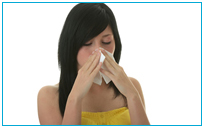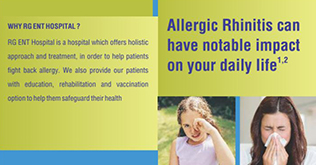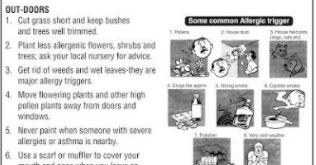Working Time
RG ENT Hospital, New Railway Road
- Mon-Sat 10:30 AM -
01:00
PM
Mon-Thu 06:30 PM - 08:00 PM
- Mon-Sat 09:00 AM -
10:00
AM
Mon-Sat 05:00 PM - 06:00 PM
Dr Rahul Garg is also available in Sector 23 with appointment
Contact Info
-
Phone: +91-124-2223931
09212313931
Whatsapp 8826992042 - rgenthospital@gmail.com
Allergies

Causes

Allergies are relatively common. Both genetics and environmental factors play a role. Allergy is caused by an oversensitive immune system, which leads to a misdirected immune response. The immune system normally protects the body against harmful substances, such as bacteria and viruses. It reacts to substances (allergens) that are generally harmless and in most people do not cause a problem.
But in a person with allergies, the immune response is oversensitive. When it recognizes an allergen, it releases chemicals, such as histamines. This causes itching, swelling, mucus production, muscle spasms, hives, rashes, and other symptoms, which vary from person to person.
Certain medical conditions such as sinus problems, eczema, and asthma are linked to allergies. Common allergens include pollen, mold, pet dander, and dust. Food and drug allergies are common. Allergic reactions can also be caused by insect bites, jewellery, cosmetics, and other substances. Some people have allergy-like reactions to hot or cold temperatures, sunlight, or other environmental triggers. Sometimes, friction (rubbing or roughly stroking the skin) will cause symptoms.

Whether or not you are likely to develop allergies is often passed down through families. If both your parents have allergies, you are likely to have allergies. The chance is greater if your mother has allergies. Allergy testing may be needed to determine if the symptoms are an actual allergy or caused by other problems. For example, eating contaminated food (food poisoning) may cause symptoms similar to food allergies. Some medications (such as aspirin and ampicillin) can produce non-allergic reactions, including rashes.

Skin testing is the most common method of allergy testing. One type of skin testing is the prick test. It involves placing a small amount of the suspected allergy-causing substances on the skin, and then slightly pricking the area so the substance moves under the skin. The skin is closely watched for signs of a reaction, which include swelling and redness. Skin testing may be an option for some young children and infants.
Blood tests can measure the levels of specific allergy-related substances, especially one called immunoglobulin E (IgE). A complete blood count (CBC), specifically the eosinophil white blood cell count, may also help reveal allergies. In some cases, the doctor may tell you to avoid certain items to see if you get better, or to use suspected items to see if you feel worse. This is called "use or elimination testing." This is often used to check for food or medication allergies. The doctor may also check your reaction to physical triggers by apply heat, cold, or other stimulation to your body and watching for an allergic response. Sometimes, a suspected allergen is dissolved and dropped into the lower eyelid to check for an allergic reaction. This should only be done by a health care provider.
Treatment
The best way to reduce symptoms is to try and avoid what causes your allergies in the first place. This is especially important for food and drug allergies.
DRUG THERAPY : There are several types of medications available to prevent and treat allergies. Which medicine your doctor recommends depends on the type and severity of your symptoms, your age, and overall health.
Alkaline nasal wash or JALNEETI : Jalneeti is a part of ancient yoga system. In modern terminology it is similar to nasal irritation and washing. It involves instilling saline water from one side so that it can come out from other side. It is very beneficial in post-operative cases as well as those of allergic rhinitis. Some time it can also be used for drug instillation.
ALLERGY SHOTS (SCIT subcutaneous immunotherapy) : Allergy shots (immunotherapy) are occasionally recommended if the allergen cannot be avoided and symptoms are hard to control. Allergy shots keep your body from over-reacting to the allergen. Regular injections of the allergen are given, with each dose slightly larger than the previous dose until a maximum dose is reached. They do not work for everybody and require frequent doctor's visits.
ALLERGY DROPS (SLIT sublingual immunotherapy) : Allergy drop treatment works similar to shots by delivering a slowly increasing dose of physician-prescribed antigen that, over time, builds the body’s tolerance. The difference is that the drops are placed under the tongue and affect the immune system through very specialized cells found under the tongue. Research shows these cells are a friendlier and effective route for long-term desensitization, making it an ideal option for patients who aren’t candidates for shots. Patients take allergy drops each day for three to five years.
Outlook
Most allergies can be easily treated with medication. Some children may outgrow an allergy. This is particularly true of food allergies. However, as a general rule, once a substance has triggered an allergic reaction, it continues to affect the person.
Allergy shots are most effective when used to treat those with hay fever symptoms and severe insect sting allergies. They do not work well for food allergies. Allergy shots may require years of treatment, but they work in about two-thirds of cases. However, they may cause uncomfortable side effects (such as hives and rash) and dangerous outcomes (such as anaphylaxis)
Prevention
Breast-feeding children for at least 4 months or more may help prevent atopic dermatitis cow milk allergy, and wheezing in early childhood. However, changing a mother's diet during pregnancy or while breast-feeding does not seem to help prevent allergy-related conditions. For most children, changing diet or special formulas does not seem to prevent these problems.
There is also evidence that infants exposed to certain airborne allergens (such
as dust mites and cat dander) may be less likely to develop related allergies.
This is called the "hygiene hypothesis" and sprang from observations that
infants on farms tend to have fewer allergies than those who grow up in
environments that are more sterile.
Once allergies have developed, treating
the allergies and carefully avoiding those things that cause reactions can
prevent allergies in the future.





